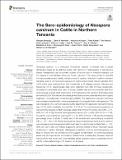| dc.description.abstract | Neospora caninum is a protozoan intracellular parasite of animals with a global
distribution. Dogs act as definitive hosts, with infection in cattle leading to reproductive
losses. Neosporosis can be a major source of income loss for livestock keepers, but
its impacts in sub-Saharan Africa are mostly unknown. This study aimed to estimate
the seroprevalence and identify risk factors for N. caninum infection in cattle in northern
Tanzania, and to link herd-level exposure to reproductive losses. Serum samples from
3,015 cattle were collected from 380 households in 20 villages between February and
December 2016. Questionnaire data were collected from 360 of these households.
Household coordinates were used to extract satellite derived environmental data from
open-access sources. Sera were tested for the presence of N. caninum antibodies using
an indirect ELISA. Risk factors for individual-level seropositivity were identified with logistic
regression using Bayesian model averaging (BMA). The relationship between herd-level
seroprevalence and abortion rates was assessed using negative binomial regression. The
seroprevalence of N. caninum exposure after adjustment for diagnostic test performance
was 21.5% [95% Credibility Interval (CrI) 17.9–25.4]. The most important predictors of
seropositivity selected by BMA were age greater than 18months [Odds ratio (OR) = 2.17,
95% CrI 1.45–3.26], the local cattle population density (OR = 0.69, 95% CrI 0.41–1.00),
household use of restricted grazing (OR = 0.72, 95% CrI 0.25–1.16), and an increasing
percentage cover of shrub or forest land in the environment surrounding a household
(OR = 1.37, 1.00–2.14). There was a positive relationship between herd-level N. caninum
seroprevalence and the reported within-herd abortion rate (Incidence Rate Ratio = 1.03,
95% CrI 1.00–1.06). Our findings suggest N. caninum is likely to be an important cause
of abortion in cattle in Tanzania. Management practices, such as restricted grazing, are
likely to reduce the risk of infection and suggest contamination of communal grazing
areas may be important for transmission. Evidence for a relationship between livestock
seropositivity and shrub and forest habitats raises questions about a potential role for
wildlife in the epidemiology of N. caninum in Tanzania. | en_US |

